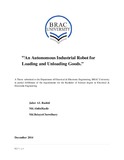| dc.description.abstract | In industries loading and unloading of heavy loads manually is one of the most imporant task which turns out to be quite difficult, time-consuming and risky for humans.In this modern era robots are being developed for various purposes to accomlish many tasks which seem to be too complex for humans. Benefits of using robots, for industrial purpose have been immense in terms of speed and efficiency of doing required tasks compare to that of humans. The paper illustrates the mechanical design of the industry based automated robot which include: Ackerman Steering Mechanism and Differential Mechanism.Ackerman Steering allows front two wheels to turn left and right in the track without going out of the track.Differential has been mounted with two back wheels and a DC motor has been used with its controller to start motion of the robot. This industrial robot has got three features and they are: Path-Tracking, Avoiding Collision, Loading and Unloading heavy industrial goods. The autonomous robot is designed to start its movement from a starting position where goods are loaded on it, then follow a path of white line drawn on black surface and unload goods by itself after reaching a destination place. Digital Line Following sensor has been mounted infront of the robot so thar the sensor can detect path by emitting and receiving signals alowing it to move in the pre-defined track having left and right turns while carrying goods from starting position to the destination. Arduino Uno has been used for programming and the required control circuit of the robot has been designed for controlling the robot’s movement within the defined path. Relay Switches have been used to control the braking, and actuator movement during left and right movement of the industrial robot. The main aim is to load and unload heavy goods that has been achieved by two large linear actuators for producing required torque and force necessary to unload heavy loads (up to more than 150kg) sideways to the ground safely.Besides, the robot has been built up having the ability to avoid collision with any obstacles that come in its way. Ultrasonic sensor has been attached with the robot to send the signal and detect the presence of any obstacle that may appear in its path and stop momentarily for certain time until the obstacle move away. Building an industrial robot with moderate Speed, good Efficiency for loading and unloading purpose within a short time to ease human suffering has been the main focus of this paper. | en_US |

